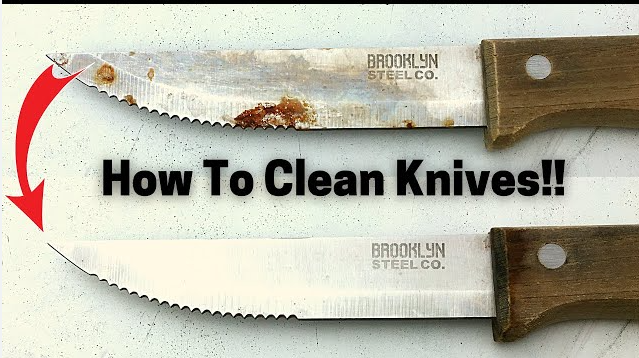How to Clean Rust Off of Stainless Steel Kitchen Knives?
Stainless steel kitchen knives are favored because they are non-corrodible and easy to maintain. Nonetheless, it is important to understand that each of the types of stainless steel cutlery can actually rust, that is, given certain conditions or if proper care is not observed concerning the knives. Also, it brings change in the outlook of the knife and hence changes the outlook of the knife, the usage of the knife, hygiene levels of the knife. That is why it is vital to learn how to handle the rust in stainless steel kitchen knives and how to process it in order to maintain the knives properly so that they may work as expected and can last longer.

Tips on Cleaning Stainless Steel Kitchen Knives
Gather Supplies
A small quantity of mild dishwashing soap, a soft cloth or sponge, non-scratch scrubber, ordinary white vinegar, baking soda, and specific paper. These are the needful items that will help you in derusting your stainless-steel kitchen knives. It would be very helpful if you could make sure all these things are within your reach before you proceed with cleaning. When you are well-prepared, he stressed that you will be in a better position to handle the rust as required.
Assess the Damage
First, assess the degree of rust on the knife. That is, if there is just a thin layer of rust, it may be simple to remove it. However, in bad situations, you might require a stronger approach. The thoroughness of the rust is essential in ascertaining the method of cleaning to use. While considering the methods of removal, light surface rust can be removed using only soap and water or a paste of baking soda. But as for the deeper penetration of the rust into the metal, it is recommended to use vinegar or other products that remove rust. Knowing the degree of rust will let you select the relevant strategy without harming your knife further.
Soap and Water
Begin by holding the knife under warm water and use some soap to clean the blade appropriately. To clean the surface, you should use a soft sponge or cloth squeezing the soapy water, and wash the surface in circular movements. This will help clean off the rust and will also create a rough surface that will make it easy to grip. What is done initially is to wash the knife under warm water with soap to manage to wipe out the easily removable substances on the knife. The use of mild dish soap softens the fat and also assists in pulling the rust and the warm water assists in softening the rust. Rinsing the knife with a soft sponge or cloth is actually the best way of washing it because it will not harm the surface of the knife. This gentle approach is particularly effective for light surface rust – and can serve as your initial first line of attack to restore your knife back to its original appearance.
Baking Soda Paste
For some clumped spots of rust, it is useful to make the baking soda paste with some amount of water. Rub this paste on the sections where rust has formed and allow it to rest for a couple of minutes. Then remove it and use a non-abrasive surface to rub the residue off gently. Baking soda is somewhat rough but not as harsh as some of the other cleaning agents; it will help remove rust stains without damaging the surface of the utensil. With this action of applying water and paste directly on the surface affected by rust, you are effectively using baking soda. It is recommended that you allow it to stand for a few minutes before proceeding to rub it so that it can soften and get into the substance causing the rust. Next, with a soft-bristle brush or sponge, you can try to rub more vigorously the area where the rust has developed in order to clean it. This approach is ideal for average hard stains on cutlery and is safe on stainless steel utensils such as knives.

Scrubbing
When washing, use a soft-bristled brush to get rid of any remaining rust, especially after you have soaked the article. More so, do not apply too much pressure during washing to avoid scratching the stainless steel surface. Another essential thing to remember is to use the non-abrasive scrubbing pad with extra care when washing the remaining rust after the soaking process; do not scrub too hard. However, to make stainless steel scratch-proof, rigorous rubbing using an abrasive surface cannot be recommended since it can cause deep scratching and the surface may already be compromised due to rust. Using a non-abrasive pad and applying gentle pressure over the areas that were not covered with the previous rust-producing material will help to eliminate the rest of the rust without damaging the stainless steel of the knives.
Rinse and Dry
After the rusting is eliminated, it is good to wash with water to ensure that the remains of the vinegar and the baking soda are washed off the knife. Wipe the knife with another towel or several sheets of paper to make sure it is dry. Stagnant moisture increases the chances of rust if it is left on the blade.
Oil the Blade
To avoid further rusting the knife blade should be oiled with a thin coat of food-grade mineral oil or a specific knife oil. This will form layers that will help shield the material from dampness and moisture. Wiping down the blade and then rinsing; it is advisable to apply a thin coating of food-grade mineral oil or specialized knife oil to the blade to help prevent further rusting. This outer shielding assists in protecting against the penetration of moisture, which is one of the chief factors that lead to the development of rust on stainless steel knives. It can be useful to make knife maintenance a part of your routine so that you are able to benefit from sharp, reliable knives year after year. Just ensure that the remaining portions of the cloth have no remnants of oil to avoid the accumulation of dust or dirt on them.
Storage
Due to better retention of moisture in the air, care should be taken to ensure that the knives are stored in a dry place to ensure that rust does not form on their surface. There are several ideas for knife storage; these are knife blocks or even magnetic knife strips if one wants proper organization.
Conclusion
It is crucial to properly clean and maintain Sakuto Knives mostly made of stainless steel. Although the presented step-by-step guide will help to remove rust and clean knives, it is better to adhere to some basic safety rules: Assess the rust carefully, use soap and water for knife washing, apply the baking soda paste for dirty stains, and gently scrub the knives. It is recommended to cover your knives immediately with a thin layer of food grade mineral oil or specialized knives oil, and store your knives in a dry place, be it a knife block or on a bar of magnet, to prevent future rust building and to keep your knives hallmarked and safe for use, for a long time. To ensure that kitchen knives made of stainless steel last long enough to give you service in every culinary task, it is important to be cautious while using them.
If the rust condition does not change after drying, you might try putting the knife into a solution of white vinegar. A container should be filled with a sufficient quantity of vinegar to cover up the blade entirely. This is what the reader can get at the end of this passage: After 5-10 minutes, let the knife soak. One of the common and simple materials that can be used to dissolve rust is vinegar, and it contains an element called an acid.

